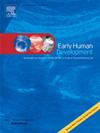Anthropometric measurements of infants in a risk-based patent ductus arteriosus treatment program
IF 2
3区 医学
Q2 OBSTETRICS & GYNECOLOGY
引用次数: 0
Abstract
Objective
This study aims to compare growth patterns among preterm infants with different patent ductus arteriosus (PDA) outcomes. Specifically, it examines infants who successfully closed their PDA following early medical therapy, those who failed to achieve closure and low-risk infants who did not meet the threshold for medical treatment of their PDA.
Study design
This was a retrospective observational cohort study conducted in a level III neonatal intensive care unit. Preterm infants born <29 weeks gestation were treated with medical therapy if they were deemed high risk as per the EL-Khuffash PDA Severity Score. Anthropometric measurements at birth, day 14 and 36 weeks corrected gestational age (CGA) were compared between low-risk (untreated), high-risk treatment-failure and high-risk treatment-success infants.
Results
74 low-risk, 52 high-risk treatment-failure and 58 high-risk treatment-success infants were identified. By 36 weeks CGA, there were no differences in weight between groups. However, high-risk treatment-failure infants showed a sustained decline in occipitofrontal circumference (OFC) metrics, while high-risk treatment-success infants demonstrated stable trajectories from birth to 36 weeks CGA (OFC centile change −15 ± 28 vs 0 ± 47 and OFC z-score change −0.5 ± 0.9 vs 0 ± 1.6, respectively). Low-risk infants maintained higher OFC centiles and z-scores at 36 weeks CGA. Gestational age at birth significantly predicted OFC centile change (β = 0.34; p = 0.01) and successful PDA closure positively impacted OFC z-score trajectories (β = 0.2; p = 0.01).
Conclusion
Our findings suggest that there may be an association between PDA closure and OFC z-score change in high-risk preterm infants.
基于风险的动脉导管未闭治疗方案中婴儿的人体测量测量
目的比较不同动脉导管未闭早产儿的生长模式。具体而言,它检查了在早期药物治疗后成功关闭PDA的婴儿,未能关闭PDA的婴儿和未达到其PDA医疗阈值的低风险婴儿。研究设计:这是一项在三级新生儿重症监护病房进行的回顾性观察队列研究。根据EL-Khuffash PDA严重程度评分,如果早产婴儿在妊娠29周时被视为高风险,则接受药物治疗。比较低风险(未治疗)、高风险治疗失败和高风险治疗成功婴儿出生时、第14天和36周校正胎龄(CGA)的人体测量值。结果共发现低危患儿74例,高危患儿52例,高危患儿58例。到36周时,各组体重无差异。然而,高风险治疗失败的婴儿枕额围(OFC)指标持续下降,而高风险治疗成功的婴儿从出生到36周CGA表现出稳定的轨迹(OFC百分位数变化为- 15±28 vs 0±47,OFC z评分变化为- 0.5±0.9 vs 0±1.6)。低风险婴儿在孕龄36周时保持较高的OFC百分位数和z分数。出生胎龄显著预测OFC百分位变化(β = 0.34;p = 0.01),成功的PDA闭合正影响OFC z-score轨迹(β = 0.2;p = 0.01)。结论高危早产儿PDA闭合与OFC z-score变化之间可能存在关联。
本文章由计算机程序翻译,如有差异,请以英文原文为准。
求助全文
约1分钟内获得全文
求助全文
来源期刊

Early human development
医学-妇产科学
CiteScore
4.40
自引率
4.00%
发文量
100
审稿时长
46 days
期刊介绍:
Established as an authoritative, highly cited voice on early human development, Early Human Development provides a unique opportunity for researchers and clinicians to bridge the communication gap between disciplines. Creating a forum for the productive exchange of ideas concerning early human growth and development, the journal publishes original research and clinical papers with particular emphasis on the continuum between fetal life and the perinatal period; aspects of postnatal growth influenced by early events; and the safeguarding of the quality of human survival.
The first comprehensive and interdisciplinary journal in this area of growing importance, Early Human Development offers pertinent contributions to the following subject areas:
Fetology; perinatology; pediatrics; growth and development; obstetrics; reproduction and fertility; epidemiology; behavioural sciences; nutrition and metabolism; teratology; neurology; brain biology; developmental psychology and screening.
 求助内容:
求助内容: 应助结果提醒方式:
应助结果提醒方式:


